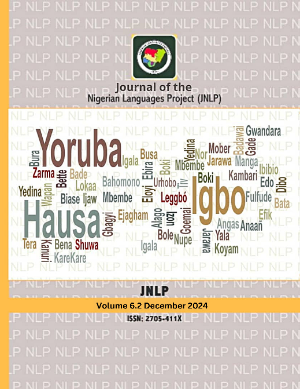Articulation of Igbo vowel sounds by Tongue-tied children: An experimental analysis using PRAAT
DOI:
https://doi.org/10.60787/jnlp.v6i2.75Keywords:
mis-articulation, tongue-free, tongue-tie, IgboAbstract
It is widely accepted that every typically developing child will acquire the language(s) to which they are exposed, often effortlessly, as posited in Chomsky’s (1963) Language Acquisition Device (LAD) theory. However, certain speech impairments, sometimes subtle and difficult to detect, can hinder effective language acquisition. One such impairment is tongue-tie, a condition that can significantly affect speech production. This study focuses on the phonetic consequences of tongue-tie in the articulation of Igbo vowels by Igbo-speaking children. The research undertakes an experimental phonetic analysis to examine the ease or difficulty experienced by children with tongue-tie during vowel articulation. Data were purposively collected from five Igbo children aged between eight and sixteen through structured observations and oral interviews, using sound articulation tasks. The participants were asked to pronounce words containing Igbo vowels positioned at word-initial, wordmedial, and word-final locations. The recorded data were analyzed using the Praat software. Findings from the study reveal that back vowels pose the greatest articulation challenges for Igbo children with tongue-tie. These results highlight the need for early detection and intervention to support affected children in achieving clearer and more accurate speech.
References
Ankyloglossia “pseud”. Retrieved on 20th April, 2018 via https://en.wikipedia.org/wiki/Ankyloglossia
Aras M. H., Göregen M., GüngörmüÅ. Â. M, Akgül H. M. (2010). Comparison of diode laser and: YAG lasers in the treatment of ankyloglossia. Photomed Laser Surg. 28(2):173-177.
Bendor-Samuel, J. (Ed.) (1989). The Niger-Congo Languages. England: University press of America.
Coryllos, C. Genna, W. & Salloum, A. (2004). Congenital tongue-tie and its impact on breastfeeding. Breastfeeding: Best for Mother and Baby, American Academy of Pediatrics, 1–6.
Egaga, P. I. (1997). Helping children to listen and speak. The exceptional child; The journal of the National council for exceptional children. 1(2) 15-18.
Emenanjo, E. N. (2011). A unified standard orthography for the Igbo language cluster (Nigeria). Centre for advanced Studies of African Society (CASAS), and Centre for Black and African Arts and Civilization (CBAAC).
Fernando, C. (2021). Tongue-tie: From confusion to clarity. Australia: Tandem publications.
Garuba, A. (1996). Basics of special education. Oyo: Educational and Management services. (EMS).
Gomwalk, S. H. (2007). Language disorders, In Ozoji, E. D. & Okuoyibo, J. M. The practice and future of special needs education in Nigeria: A book of readings in honour of Prof. (Rev. Sr.) T.B. Abang. pp.66-78 Jos: Deka Nigeria.
Heward, W. L. & Orlansky, M. D. (1984). Exceptional children. Columbus: Bell and Howell co.
Horton CE, Crawford H. H, Adamson J.E., Ashbell T.S. (1969). Tongue-tie. The Cleft palate journal. 6: 8–23.
Hyman, L. M. (1975). Phonology Theory and Analysis. USA: Holt, Rinehart and Winston.
Katamba, F. (1989). An introduction to phonology. London: Longman.
Lingua Language Centre, (2023). Most spoken languages in the world. Retrieved on the 23rd June, 2023 via lingua.edu/the-mostspoken-languages-in-the-world/.
O’Grady, Archibald & Katamba F. (2011). Contemporary linguistics. An introduction. England: Pearson Education Limited.
Ohiri-Aniche, C. (2013). Igbo speech varieties. Abuja: Centre for Igbo Arts & Culture.
Okeke, B. A. (2001). Essentials of special education. Nsukka: Afro-Orbis Publications.
Omachonu, G. S. (2010). Fundamentals of English phonetics and phonology. Enugu: Rossen Publications Ltd.
Ongun, M., Gumus, N. M., Ünsal, S., Yildirim, A., Yüksel, S., Yüksel, M., & Gündüz, M. (2017). Research on articulation problems of Turkish children who have Down syndrome at age 3 to 12. International Journal on disability and Human Development. D.O.I :org/10.1515/ijdhd-2016-0017. https://www.degruyter.com/document/doi/10.1515/ijdhd-2016-0017/html
Perkins, W. H. (1971). Speech pathology: An applied behavioral science. Louis C. V: Mosby.
Roach, P. (1997). English Phonetics and Phonology. Cambridge: Cambridge University press.
Sedano, H. O. (1975). Congenital oral anomalies in Argentinian children. Community Dentistry and oral epidemiology, 3(2), 61–63.
Todd, D. (2014). Tongue ties: Divide and conquer? To divide and prevent an interruption in breastfeeding. Australian Breastfeeding Association Seminars for Health Professionals.
Todd, D. & Hogan, M. J. (2015). Tongue tie in the newborn: Early diagnosis and division prevents poor breastfeeding outcomes. Breastfeeding Review, 23(1), 11–16.
Travis, L. E. (1971). Handbook of speech pathology and audiology. New Jersey: PrenticeHall Inc.
Van Riper, C. (1972). Speech Correction: principles and methods. New Jersey: Prentice-Hall Inc.
Wattis, R. K. & Douglas, P. S. (2017). Three experienced Consultants reflect on the Oral tie’s phenomenon. Breastfeeding Review, 25(1), 9-15.











